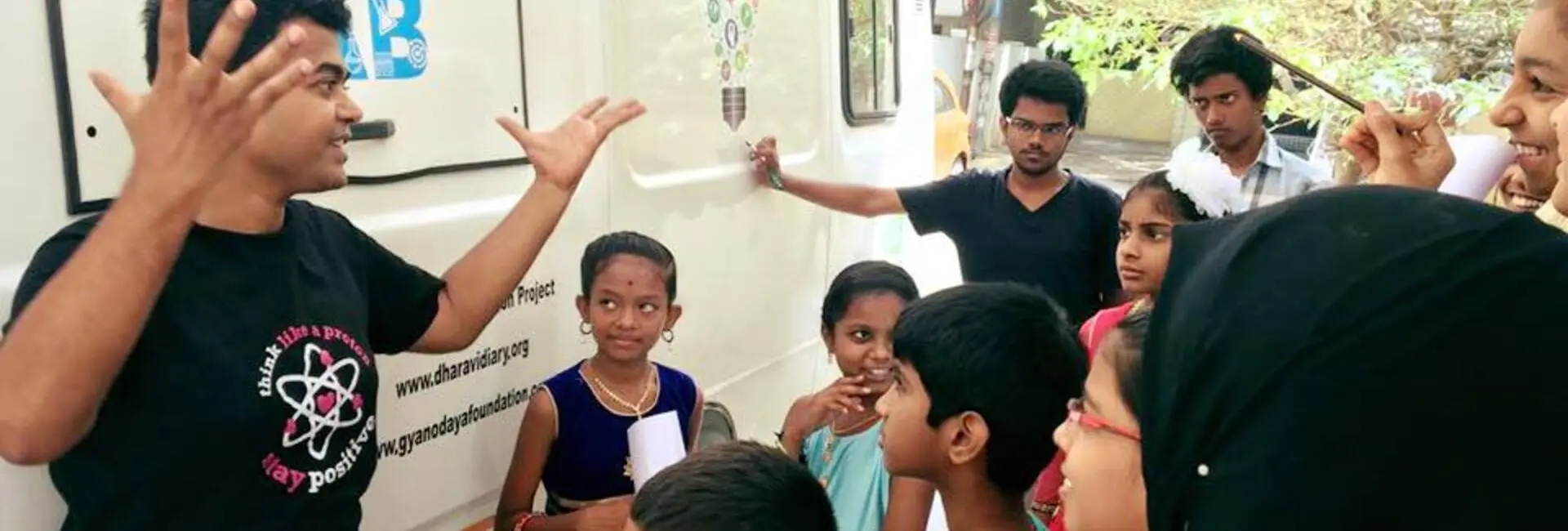(October 16, 2024) A few days ago, Suman Sharma, a resident of Dharavi, found herself presenting a report at Dharavi Diary’s monthly meeting. Fluent in English, she took on the center stage and presented her team’s work with much elan. But she wasn’t this confident when she first went to Dharavi Diary’s after-school program in Asia’s largest slum many years ago as an eighth grader. Now a senior fellow at the nonprofit that empowers youth through STEAM learning, storytelling, and skill building, she is helping first-generation college goers in the slum navigate challenges by sharing her experience of studying at SIES College, one of the top five colleges in Mumbai. Initially, she never considered achieving the feat as the daughter of a carpenter father from UP and a homemaker mother. But things changed when she first joined Dharavi Diary, an initiative started by filmmaker and changemaker Nawneet Ranjan, who returned from the US to give back and create an impact. “Suman is now planning to get into fashion designing. She designs bags and sells them online. Many girls like her, who reside in Dharavi, are chasing their dreams after learning the necessary skill set,” Nawneet tells Global Indian.

Nawneet Ranjan
Started in 2014 as a post-school slum innovation program in Dharavi, the nonprofit has till now impacted over 600 students. It began while shooting his documentary – Dharavi Diary – when he came across young girls who had the potential to change their lives. His documentary travelled across the globe and as a gesture of giving back, Nawneet started the nonprofit. “I realised that there is so much to do in India. Even if I can change a few lives, that would be my way of giving back because they gave me this documentary,” he adds. Through the power of storytelling and tech education, Nawneet has created local heroes in Dharavi who are an inspiration in the neighbourhood.
It was the love for storytelling, filmmaking, and social change that led Nawneet Ranjan to the streets of Dharavi a decade ago. Little did he know that it would give him a purpose as a changemaker.
A Filmmaker’s Journey: From San Francisco to the Streets of Dharavi
Having dabbled in advertising, copywriting, theatre and poetry, Nawneet Ranjan found his true calling in filmmaking. It was the art of storytelling that intrigued this Muzaffarpur-born since childhood. “I lied with conviction as a child and came up with excuses that made good stories,” he laughs. Born in a family of academicians and bureaucrats, Nawneet was interested in the creative side of things. While his parents encouraged him to hone his craft, they were skeptical about him pursuing it as a career.

However, he wanted to follow his heart and began his journey by exploring theatre, where he understood the true power of storytelling and its impact. Travelling across the country with theatre groups brought him into the company of people from diverse backgrounds. It was storytelling that always pulled him, either to theatre or to film festivals. Having experienced theatre and films in India, he felt the pull to explore “the otherness.” “I knew how films were taught in India but I wanted to experience how it worked in other parts of the world.” This led him to the Academy of Art University in San Francisco for his MFA in direction and screenwriting on a partial scholarship. “I chose San Francisco as it’s a city rich in diversity which brings to the table different points of view. In our class of 19 students, we had people from over 12 nationalities. That’s the kind of ‘otherness’ I wanted to experience.”
Arriving in the US in the fall of 2010, Nawneet Ranjan quickly realised that he wasn’t just representing his family or educational background – he was representing India abroad. “It made me think what different can I bring to the table. It pushed me to stay focussed as I wanted to be known beyond my colour and ethnicity.” He adds, “It also gave me a global perspective on storytelling, on myself and on how tiny I was in the larger scheme of things,” says Nawneet, who strongly recommends everyone to live in another country at least once, as the experience of otherness can shape one’s perspective on life.
Surrounded by students from across the world, he experienced varied cultural nuances and diversity firsthand, which shaped his approach to storytelling. “Everyone brought their own stories, which was an incredible learning experience. It made us realise that despite our different ethnicity, our emotions are universal,” he recalls.
During his four-year stay in the US, Nawneet Ranjan found himself not just learning the craft of filmmaking but also deeper lessons about inclusivity, diversity, and his privileges. “I learnt how privileged I was while working on some social projects in the US,” reveals the filmmaker, who often visited Mumbai during his college breaks. “That’s when I learnt about the Dharavi redevelopment plan.”

Around the time, he lost his mother, a middle school principal, and this personal loss stirred up a deep sense of responsibility in him to return to India to give back to his homeland. “In the US, I saw many organisations using storytelling as a tool for different causes. I felt I should return and use my skills to empower and uplift others.”
Dharavi Diary: A Catalyst for Change
He vividly remembers watching the 2008 Oscar-winning film Slumdog Millionaire. Though he appreciates the film’s structure, Nawneet feels Dharavi wasn’t presented in a way that captured its reality. Eager to tell the authentic stories of those living in Asia’s largest slum, he came to Mumbai in 2014 to make a documentary on Dharavi. “I wanted to showcase real stories through interviews and highlight what’s happening in Dharavi. Many people opened their doors to offer us a glimpse into their lives,” says Nawneet, revealing that 90 percent of Dharavi’s population consists of migrants with no land of their own back home. “They see opportunity in Mumbai, and since Dharavi is placed right in the center and well connected through central and western railways, it promises the hope of a job. Many residents find work either in the city or within Dharavi itself, often in recycling plants, which has become a major source of employment” explains the filmmaker.

The poster of Dharavi Diary
During the filming, he came across young girls, mostly eldest siblings in the families, who took on the role of caretakers while their mothers went to work each day. “Although none of them attended school, through interactions, I realised they were bright and had potential. So, I decided to give them laptops and train them in software.” This gave birth to Dharavi Diary, using the same name as his documentary.
Empowering Girls, Rewriting Narratives
It began as an after-school program in the neighbourhood, calling in mostly girls as he saw them facing discrimination at home in terms of nutrition or sanitation or education. “It was important to engage and empower them by providing skill sets and methodology of how they can change their narratives,” says Nawneet, who also taught them coding to create mobile apps. “I wanted them to know that though their beginnings have been hard but they have the power to change their story any time. All they need to do is to take action in hope that tomorrow will be better than today.”
In the last 10 years, Dharavi Diary has impacted over 600 students, through their centres in Mumbai, Pune, and tech labs in Bihar. “We need stories of superheroes but we need local heroes, who can inspire, connect with people and make an impact in their community. These girls played an important role in eradicating child marriages and domestic abuse in their homes and neighbourhood by learning about intervention through the programs,” reveals the changemaker. What began as a girls post-school program now also engages 40 percent of boys. “We initially began by training the girls but then we realised that to change the narrative, it was important to involve the boys too.”

Over the years, word of mouth and a strong chain of social workers have helped engage youth in the neighbourhood. “We train school passouts and graduates as junior fellows and senior fellows and create curriculum with the help of teachers,” says Nawneet, who even finds support in volunteers. “Through fellowship programs we help youngsters become independent so they can provide for their family.”

Local Heroes: Inspiring Change from Within
His hard work as a changemaker has paid off as many kids have become engineers, while others are pursuing nursing or law. “All of them are first-generation learners.” Nawneet is proud to have made some local heroes in the community, who are an inspiration to many in the neighbourhood. “Real leaders bring more leaders to the table,” he says, adding that Dharavi is Little India which represents diversity in the best way. “Migrants from across India reside here but we as a country have never used diversity for problem-solving.” But he is changing that with Dharavi Diary as it has started another program – Job Readiness – for first-generation college-going students. “We prepare them for their first jobs by helping them with the skill set and mindset they need to find placements.” After initiating a pilot project, Nawneet hopes to scale it up to other centres soon.

As Dharavi Diary grows, Nawneet’s mission remains clear: empowering underprivileged youth in India through education, storytelling, and skill development. His journey as a filmmaker and changemaker shows how art and social action can come together to create meaningful change. “It’s about rewriting the narrative,” he explains, driven by a deep sense of purpose. Through his programs, he equips children with the tools to transform their lives, while instilling hope and possibility in a community often overlooked. Nawneet is inspiring a new generation of storytellers and problem-solvers, ready to shape a brighter future for themselves and their community.
- Follow Nawneet Ranjan on LinkedIn
Also Read: Bunker Roy and Barefoot College: Upskilling communities and spreading practical wisdom





